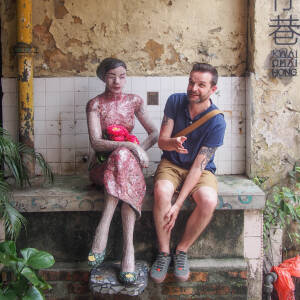Booking the Trend
This is one of several used bookshops that line a busy road near my home - all are stacked floor to ceiling with old books, and all seem to do little or no business.
The historical context for these stores however, is significant. All lie on the same street as Gwangju High School, which was once the most prestigious school in the region. The brightest students from Joellanam-Do would venture far and wide to study here.
In much poorer times, these bookshops were a lifeline to students, who could buy used textbooks at discounted prices, or even exchange books they no longer needed.
In a digital age however, and in a country that has embraced private education like no other, this public high school has long since been usurped by the abundance of private schools - and most of the once ubiquitous bookshops have vanished.
The area surrounding the high school was once the city's bustling centre, but it know feels somewhat dilapidated, more a through road to more interesting places than anything else.
The nearby central bus terminal has long since moved to a new location, and is now a large department store, and although Gwangju's main downtown area of shops, restaurants and bars is still not far from here, it feels a world away.
Another reason for the historical significance of the area is that a number of the first killings in what would become known as 'The Gwangju Massacre' took place in and around the High School.
Student protests at the power grab by military dictator Chun Doo Hwan, and his subsequent brutal crackdown on poltical gatherings and student activity, gained greater and greater numbers, as students and professors were joined by other members of the general public.
Choo however, now in full control of the media and having shut down the production of newspapers, had the uprisings reported as dangerous communist activity, and sent armed paratroopers down to Gwangju to quell the protests.
The resuting killings were both ruthless and shocking, the fear of communism helping fuel their ferocity. Unarmed civilians were shot or stabbed with bayonets, student protesters executed on the spot, and as more and more people joined the protest and managed to arm themselves, the violence intensified.
The resulting confrontations lasted around ten days before being finally quashed by the increasing numbers of government troops. The final death toll was reported at the time to be around 150, but as up to 2000 people went missing during the course of the protests it is generally believed to be much higher - several witnesses have since reported seeing piles of hundreds of bodies being taken away for burial in mass graves.
Although unsuccessful, the Gwangju Massacre is seen as a turning point in the long struggle for democracy in South Korea, and though General Choo's dicatatorship continued for several years, all subsequent movements that fought for democracy would qoute the May 18 Movement as their inspiration.
An interesting and shocking timeline of the events surrounding May 18 can be found here, and is well worth a look.
The movie 'May 18' depicts the events surrounding the uprising, including this chilling scene, in which the national anthem being pumped from loudspeakers was actually a cue for soldiers to attack.
Although the movie contains fictional characters, the events in this scene really happened, just five minutes from what is now my front door.
(click 'view larger image' for a good look at the sheer volume of books)
Just came across this interesting (and potentially worrying) article regarding the views of some of Korea's younger netizens of what the Gwangju Massacre/May 18 Movement was actually about.
- 1
- 0
- Olympus E-M5
- 1/50
- f/4.0
- 15mm
- 320

Comments
Sign in or get an account to comment.


